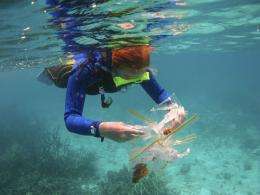Depth important in generating reef diversity

(PhysOrg.com) -- A study by University of Queensland researchers reveals that corals are more adapted to smaller ecological niches than previously thought, and provides new insights into the processes that generate diversity on coral reefs.
The findings are is important as they dispel some previously held ideas that corals from greater depths can regenerate shallow coral reefs damaged by bleaching or other climate events.
Scientists from the Global Change Institute (GCI) and the School of Biological Sciences at The University of Queensland were surprised to find that the extremely abundant coral Seriatopora hystrix (‘Bird's nest coral') actually consists of various genetically unique strains that are each associated with a particular depth range on a coral reef.
Corals were previously thought not to be so specialised across different depths.
PhD researcher Mr Pim Bongaerts said the fact that some species of corals occurred over large depth ranges on a coral reef had led people to believe that corals can be very flexible in terms of the type of environment in which they can live.
“However, we demonstrated that there is specialisation of the coral host to particular reef environments, with each strain of coral host associating only with particular types of symbiotic algae (zooxanthellae),” he said.
“The results also highlight the lack of connectivity between different habitats on a single reef, such as shallow and deep water, which has important implications under future climate change scenarios, as coral reefs will be largely dependent on neighbouring areas for their recovery.”
The Director of the Coral Reef Ecosystem lab of the GCI, Associate Professor Dr Sophie Dove, said that concurrent transplantation experiments also demonstrated that corals from deeper parts of the reef were not able to survive in the shallows.
“This essentially rules out the idea that corals from deep areas of the reef might act as a source of larvae for repopulating shallow water areas when they get damaged,” she said.
The study also has implications to how reef-building corals evolved to be so diverse.
“Classically, the diversity of corals was thought to have arisen as a result of the geographic separation of populations over time.
Our data, however, reveal a compelling case of where genetically distinct populations of corals originated at the one geographic location due to specialisation to particular reef environments.”
Mr Bongaerts said he was "pretty excited" by the discovery.
“Ecological speciation is a well-described process in tropical rainforests," he said.
"However, our work represents the first compelling evidence that this process may play an important role in the diversification of reef-building corals.
Lecturer in the UQ School of Biological Sciences Dr Cynthia Riginos said the study highlighted "how little we know about species boundaries and diversification on coral reefs, even for a common well-studied coral such as Seriatopora hystrix."
A better understanding of the processes that shape diversity and connectivity on coral reefs is crucial for the establishment of marine protected areas and to come up with strategies to mitigate the increasing human induced and climatic pressures on the world's coral reefs.
More information: The research paper “Genetic Divergence across Habitats in the Widespread Coral Seriatopora hystrix and Its Associated Symbiodinium” was published in the on-line journal PLoS One from the Public Library of Sciences: www.plosone.org/article/info:d … journal.pone.0010871
Provided by University of Queensland















